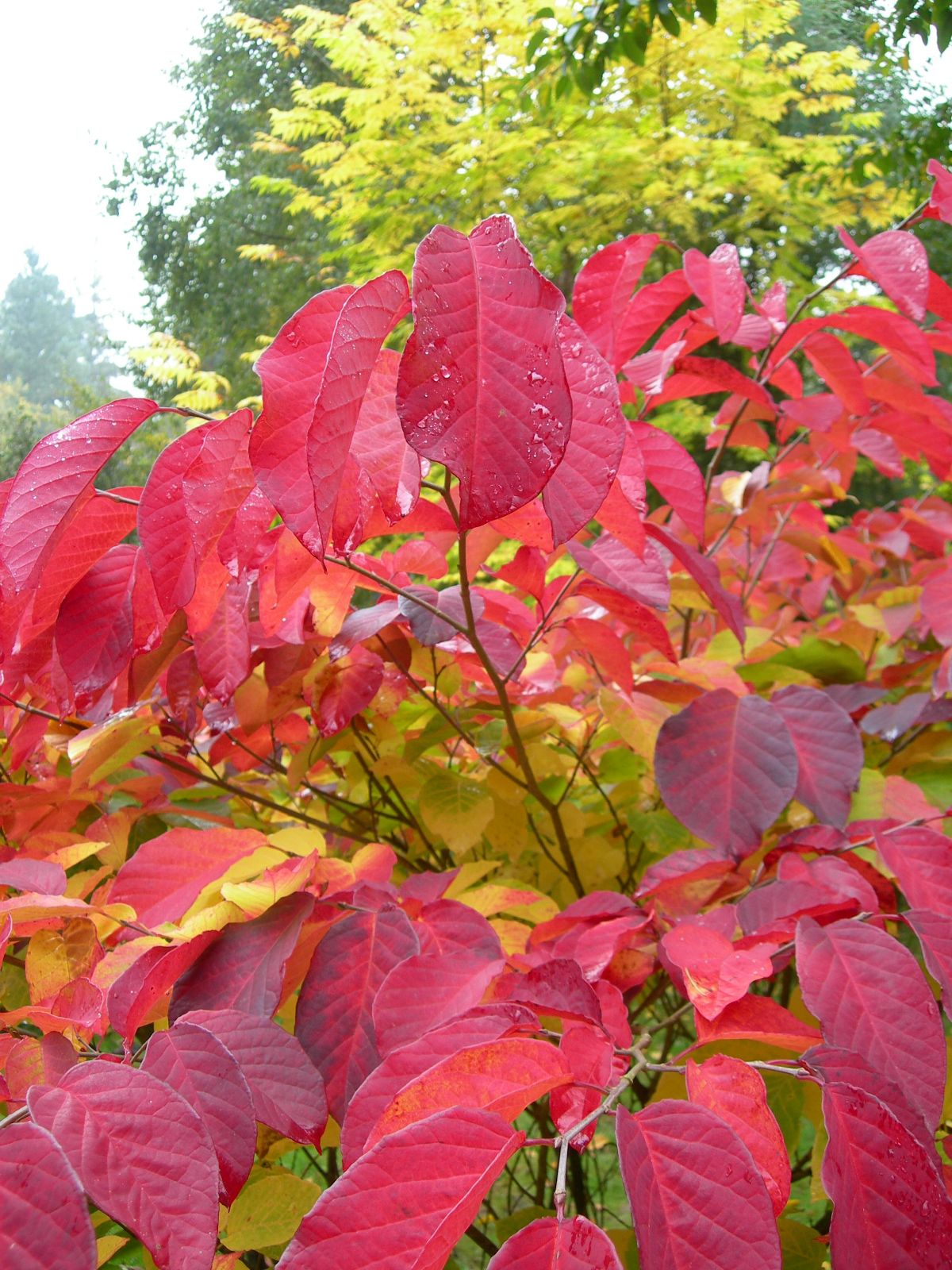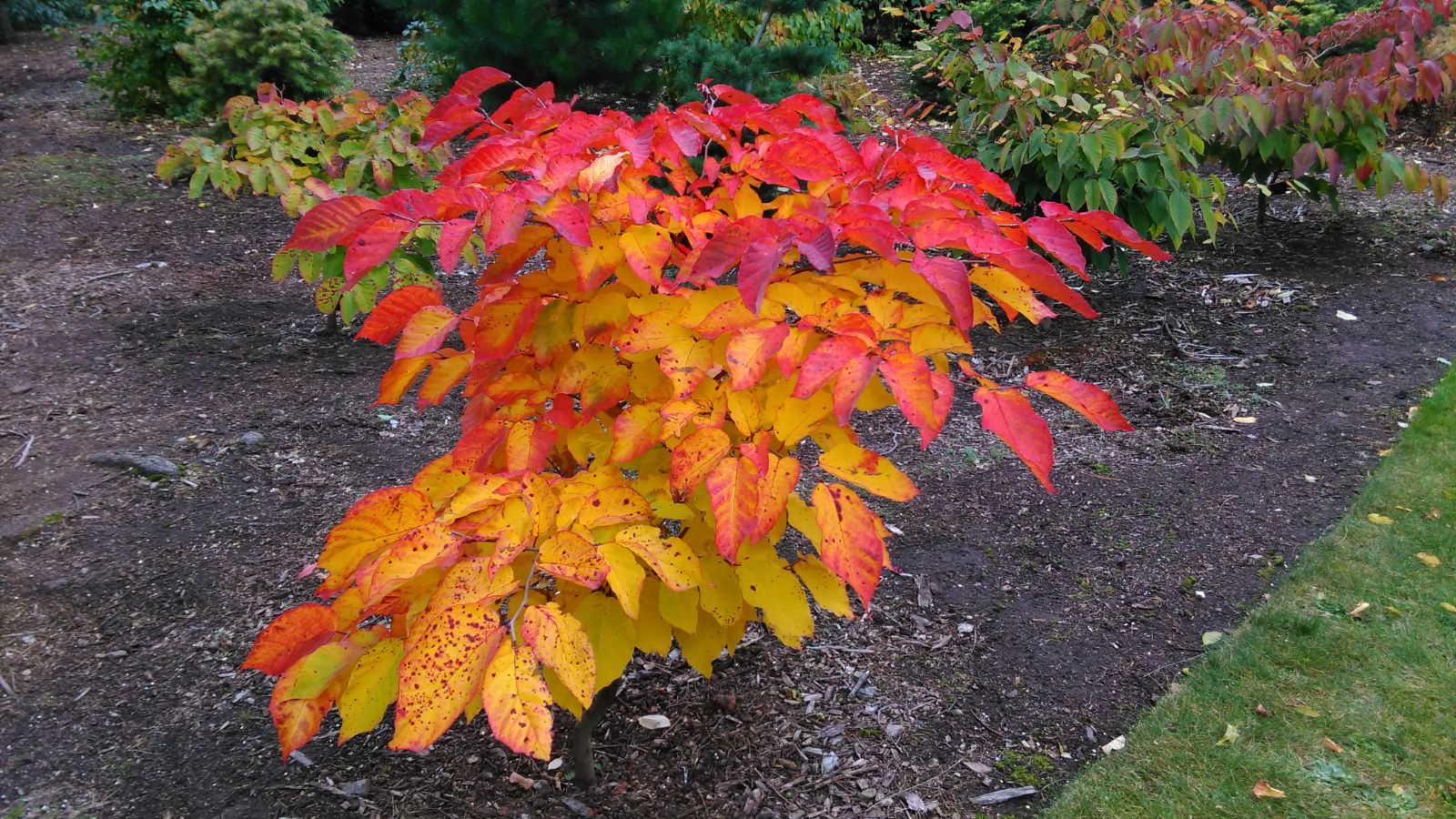Neoshirakia japonica
Credits
Harry Baldwin (2018)
Recommended citation
Baldwin, H. (2018), 'Neoshirakia japonica' from the website Trees and Shrubs Online (treesandshrubsonline.
Genus
Synonyms
- Sapium japonicum (Sieb. & Zucc.) Pax & K. Hoffm.
- Shirakia japonica (Sieb. & Zucc.) Hurus
- Stillingia japonica Sieb. & Zucc.
Other taxa in genus
Deciduous shrub or small tree to 8 m, glabrous; branches slender, smooth, grey-brown. Leaves deciduous, papery, mid-green, turning to bright red in autumn, 7–16 × 4–8 cm, ovate, ovate-oblong, or elliptic; base obtuse, truncate, or sometimes shallowly cordate, usually oblique; apex acute; margin entire; upper surface with small glands near the margin and two large glands at the base of the raised midrib, with 8–10 secondary veins on each side of the midrib; petiole 1.5–3 cm, with narrow wings; stipules membranous, linear-lanceolate, c. 1 cm. Inflorescence terminal, 4.5–11 cm, female flowers at base, male ones above, or sometimes male throughout. Male flowers in clusters of 3–4, shortly pedicellate, subtended by small bracts; calyx cup-shaped, three-lobed, lobes irregularly serrulate; corolla absent; stamens (2–)3, usually exceeding calyx; anthers globose, slightly shorter than filaments. Female flowers on stout pedicels, 6–10 mm, with bracts three-partite almost to base, lobes lanceolate, 2–3 mm, the central one usually the largest, lateral lobes each one-glandular; corolla absent; calyx lobes three, triangular, nearly as long as wide; ovary ovoid, smooth, three-celled; styles connate at base; stigma three, revolute. Capsules triangular-globose, 10–15 mm diameter; columella deciduous. Seeds oblate, 6–9 mm in diameter, spotted and striped in shades of brown. Flowering May–June, fruiting July–September (China) (Li & Esser 2008).
Distribution China Anhui, Fujian, Guangdong, Guangxi, Guizhou, Hunan, Hubei, Jiangsu, Jiangxi, Shandong, Sichuan, Zhejiang Japan Honshu, Shikoku, Kyushu South Korea
Habitat Moist temperate forests,100–700 m asl
USDA Hardiness Zone 6
RHS Hardiness Rating H6
Conservation status Not evaluated (NE)
Taxonomic note Neoshirakia atrobadiomaculata (Metcalf, Esser & Li) from southern China was described as differing from N. japonica in minor ways (shorter stature (1–3 m cf. 4–8 m) and leaf shape (ovate, ovate-rectangular, or elliptic cf. elliptic to slightly obovate) and absence of leaf glands, but is treated by most authorities as a synonym. No plants under this name are known to be in cultivation. Li & Esser (2008) note that two entities referred to as N. japonica occur in China; a future split is possible.
Neoshirakia japonica is a slow-growing deciduous shrub or small tree forming a tight arching canopy and producing a raceme of insignificant flowers; its moment of glory comes when the slightly glaucous leaves turn yellow then a deep crimson red in autumn. At this point it is one of the finest of all plants for autumn colour; in view of this it is surprising that it is not more widely cultivated, and that it is only offered for sale by a few specialist nurseries.
There is little information on the species in horticultural literature, although it was described by Bean (1981) as Sapium japonicum. The finest and oldest specimens in the UK are located at the Sir Harold Hillier Gardens, Hampshire, where two plants planted in the mid- to late 1970s were just under 5 m in 2017 (pers. obs.). It is grown at Kew, Wakehurst Place and Edinburgh, and in some private gardens including Hergest Croft, Herefordshire (R. Griffiths pers. comm. 2017) and John d’Arcy’s garden at Edington, Wiltshire. In New Zealand, it is cultivated at Eastwoodhill Arboretum.
It seems to be tolerant of a range of soil types, and has been observed in the wild growing on very sandy well-drained soils in the broad-leaved forests of the Chiba Peninsula, Japan (B. Jones pers. comm. 2015). Here the plant grows in a very humid environment with temperatures reaching 30°C in the summer months, and annual precipitation averaging 1500 mm; more than double that of the south of England. It is probable that hot summers are beneficial, with growth being slow and steady in Great Britain; it is however unhappy in the cool wet conditions of Benmore in Argyll (T. Christian pers. comm. 2018). It can tolerate very severe winters, having withstood –30°C without damage in Pennsylvania (B. Yinger pers. comm. 2015), and has prospered at Arboretum Wespelaar since the early 1980s (P. de Spoelberch pers. comm. 2015). The plants there are derived from both South Korea and Japan and fruit freely, producing numerous self-sown seedlings around the parent plants, as do the two plants at the Sir Harold Hillier gardens (T. Christian pers. comm. 2018). With its wide range in eastern Asia it may be that there is some variation in garden performance dependent on provenance.
The capsule becomes hard and dull-coloured upon ripening, but dehisces violently and noisily, projecting the seeds to some distance (pers. obs.). Trying to catch mature seeds can be tricky; collecting them just before dehiscence is preferable, followed by storage in an escape-proof paper bag. The seeds are exquisitely patterned in spots and streaks of varioius shades of brown, like attractive little eggs. Storing the seeds in a moist perlite and fungicide medium for three months at 5°C will break dormancy and initiate germination. Cuttings have proved successful for Andrew Luke (formerly Head of Arboretum Nursery) at the Royal Botanic Gardens, Kew; he states that taking 20 cm semiripe nodal cuttings in late July with a liquid IBA hormone will initiate rooting. Low winter light levels can be a problem, providing an extra seven hours of day length at night will allow the cuttings to set more root and produce enough food until spring (A. Luke pers. comm. 2017). To date, all plants inspected appear to be unaffected by pests and diseases.



